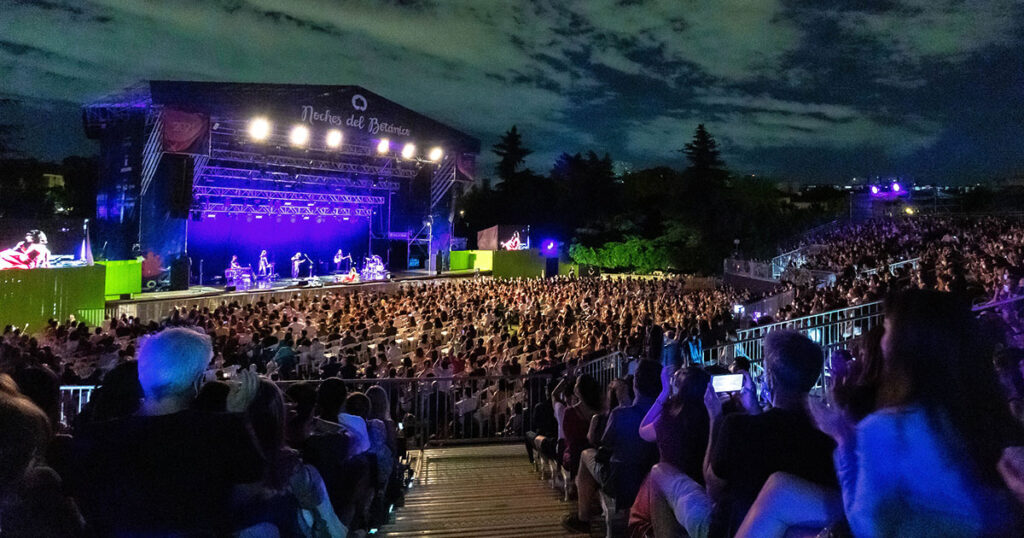
In early June, Bob Dylan gave two concerts to open Madrid’s summer music series “Noches del Botánico,” held at the Royal Botanical Garden of Alfonso XIII, in the center of the city’s University Campus. “A wonder,” Pedro Calvo wrote of the June 8 performance in an online review the next day. I was there too that night, a guest of my brother, and though I’m not sure I got as much pleasure from the songs as Calvo did, I was glad, on reading his piece, to conclude that my ticket was worth what my brother must have paid.
The pair of Madrid concerts were the first of Dylan’s Spanish tour, which included seven other cities and a total of 12 concerts. The last concert was in Barcelona on June 24. Most of the songs he played in Madrid were from his Rough and Rowdy Ways album, others from Shadow Kingdom. Not one song did I recognize. Still, I was glad to be there. A cloudburst just before Wednesday’s concert nearly got it canceled, and the threat of rain on Thursday added suspense to the fun of the evening. My brother, who’d attended the first concert as well, told of an enterprising person who had collected the free rain ponchos being handed out at the gates, then doubled back to sell them to ticket holders farther down the line. My brother bought two for four euros. But perhaps buyers weren’t such chumps after all: little good a rain poncho will do to keep you dry if you are soaking when you pull it on. And for two euros, ill-prepared concertgoers got early protection from the rain. The weather was better on Thursday but still worrisome, and at the entrance I took a pink poncho for myself and a green one for my brother. He didn’t use his but instead reused his blue one from the previous night.
Despite the thundery-looking skies, the rain held off until 9:30, just when the concert began. Most of the 2,900 seats were occupied, though some latecomers were still looking for theirs in the bleachers or among the rows in front of the stage. As the stage lights came on, a fine rain started that lasted 10 minutes, enough to wet your clothing but not to hamper your view. Dylan appeared. Everyone rose and clapped, before sitting again. Two rows up to the right, an exuberant fan continued on his feet and cheered and cheered. A few seats away on the left, a man with a bald head sat under a sheer yellow poncho, bobbing throughout the concert, looking around often as if to say, “Can you believe how great this is?” Either one of them might have been expected to pull out a phone to document the experience. At this concert, however, no one did wave a phone or snap a picture or record a video because on entering, all spectators had to stash their phones in sealed pouches. How many years back must we go to find concerts not typically interrupted by calls, messages, flashes of light from screens, and phones held aloft? Would I have used mine to capture Dylan? Forewarned by my brother, I’d left it at home.
Dylan has been known to perform for only 45 minutes, no apology for it. For us, he was on stage for one hour and 45 minutes. No encore because Dylan doesn’t do encores. When it’s over, it’s over. We headed for the gates. Just outside and facing them, a street performer was setting up his amp and mic. He picked up his guitar. As we walked out, I heard the first notes of “Mr. Tambourine Man.” My brother and I stopped with a few other concertgoers to watch and listen. The man’s style was appealing and his singing good. Most important, he played the songs I wanted to hear: songs from the past. Sure, I like Bob Dylan, but really, I’m a fan of my youth. Yes, “Mr. Tambourine Man.” Yes, “Like a Rolling Stone.” Yes, all the old songs. My brother and I grinned at each other. This performer knew his audience, and he had a living to earn, as Dylan no longer does. “How does it feel?” he wailed into his mic. “How does it feel?” sang his growing ring of spectators. A member of this happy crowd hesitated after dropping some coins onto the coat on the ground. Then he sprang forward, turned to stand beside the musician, raised his hands over his head, and commenced to sing along. The musician immediately closed the gap so the two were rubbing shoulders. The audience loved it. I’d have taken a picture, had I had my phone with me. Instead, I concentrated on remembering the musician—shoulder-length dark curly hair, gray jeans, brown leather shoes, button-up shirt. He stepped up to the mic, leaned in on his toes, sang lustily, hopped back several steps to strum, stepped forward again. The audience was soon a couple of hundred people in a large semicircle. “I love you, Spain!” he said in English. I watched and absorbed as best I could the crowd, the guitar, the lights, the singing and swaying audience, the guitar player. How did it feel? It felt grand.
Was the Dylan concert a good concert? One journalist answered that it wasn’t the best of Dylan’s career, or even the best Dylan could give at 82, but it was good. So I’d thought, until outside the venue it became even better.

